|
IN 1501, Gasper de
Cortereal, the Portuguese navigator, visited Conception Bay, and gave to
it the name which it bears, after the miraculous conception of the
Virgin Mary. He also gave the present names of many of the coves and
headlands.
A colony was attempted
to be established at Musquito Cove, Conception Bay, so early as the
reign of James I. By letters patent, dated 27th April, 1610, a company
of English gentlemen (among whom were the celebrated Sir Francis Bacon,
Lord Northampton, and Sir Francis Tan-field) were granted all that part
of the island lying between Cape Bonavista and Cape St. Mary. These
gentlemen sent a company of emigrants, under the direction of John Guy,
to plant a colony in the newly-granted territory. Guy was a Bristol
merchant, and set sail from that city in 1610, with three ships and
thirty-nine persons, as governor of the colony. He arrived at Mosquito
Cove after a short passage, where he erected a dwelling-house,
storehouse, &c., and planted a small fort of three cannon. He remained
here two years, and opened a very promising intercourse with the native
Indians, and in his letters to England, describes the climate as not so
cold as that of England, and that the brooks had not been frozen during
the depth of winter. William Colston, however, who was left in charge of
the colony after Guys return to England, did not speak so well of it.
Six of the emigrants were seized with scurvy and died.
In the summer of 1612,
Guy returned to the colony, and by judiciously treating the sick they
soon regained their health. It is said vegetables were at this period
raised, among which were turnips, which were given to the sick. Guy made
a journey along the coast, where he mot with a number of Red Indians,
shortly after which the colony was abandoned.
Conception Bay is the
most thickly settled and best cultivated part of Newfoundland. Few bays
surpass it in beauty and grandeur of scenery.
Harbour Grace is the
capital of Conception Bay, and the next Town to St. John’s. It is called
the “Brighton of Newfoundland,” on account of its beauty. The harbour is
seven miles long, at the entrance are some islands, entirely composed of
fine roofing slate, on one of those islands a splendid Light-house is
erected, there is also a harbour light. According to the census of 1857,
the population of Harbour Grace was 5,095. There are four churches, one
Episcopalian, one Roman Catholic, one Wesleyan Methodist, and one
Presbyterian. There is also a stone Court House and Gaol, which was
erected in 18.'50, with stone obtained from Kelley’s Island. The first
Court House in Conception Bay was erected about the year 1808, a few
years previous to which, Judge Reeves, the first Chief Justice of
Newfoundland, visited Harbour Grace and examined into a most disgraceful
state of things, as respected the administration of justice there. The
Courts were then conducted by floating and resident surrogates,
generally naval officers.
The following is an
account of the public meeting held, with the amount of money raised for
the erection of the Court House and Gaol in 1807:—
“At a meeting of the
magistrates and merchants in the District of Harbour Grace, in
Conception Bay, in order for raising a subscription, &c., for the
purpose of building a Court house and Jail in Harbour Grace, it was
fully resolved that the sum of twenty shillings be levied on every
thousand quintals of fish catched and shipped off in Conception Bay; and
each merchant holds himself responsible for the amount of the
collections as annexed to his name, which sums the said merchants are to
be reimbursed by leving the sum of two shillings on every hundred
quintals on each person or planter of whom they receive the said
quantity of fish, which the magistrates hereby give the authority to do.
“And it is further
resolved, that every servant employed in the fishery is to pay one
shilling for every ten pounds wages, the same as the last season ; and
that all publicans, shop-keepers, coopers, and persons not carrying on
the fishery, shall pay respectively as follows :—Every shop-keeper, the
sum of one guinea and-a-half; every cooper carrying on his trade on his
own account, the sum of one guinea; every publican not carrying on the
fishery, the sum of one guinea and such other persons that are
employed in the fishery, the sum of half a guinea. And it is also
further resolved, that all chartered vessels that shall load in
Conception Bay, and not belonging to the merchants as their own
property, that each vessel so chartered shall pay the sum of ten
shillings and sixpence for one season only.
“(Approved of)
“Chas. Garland, J. P.,
“Wm. Lilly, J. P.,
*Ls. Amad, Anspach, J. P.,
“Oliver St. John,
Secretary.
“Harbour Grame, 22nd June, I807.’’
(Enrolled.)
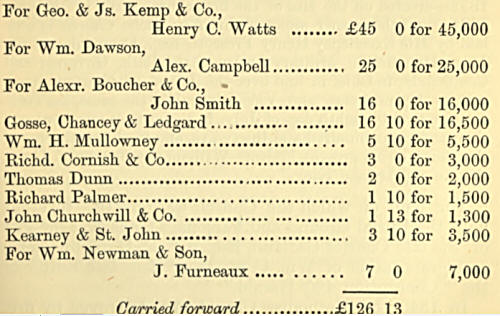
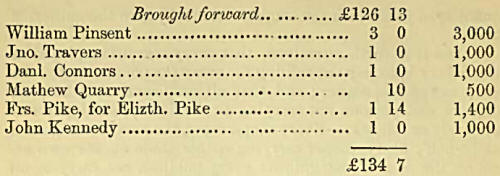
Harbour Grace has two
principal streets running through it, called Water and Harvey Streets.
There are some brick and stone buildings on Water Street.
The Church of England
of Harbour Grace is the first stone church ever built in Newfoundland.
The following is an extract from the scroll read on the occasion of the
laying of the foundation stone, by John Stark, Esq.. Chairman of the
Building Committee, and Chief Clerk and Registrar of the Northern
Circuit Court, which was deposited in a bottle beneath the foundation
stone.
“Here stood St. Paul’s
Church, which was burnt to the ground by the great fire at Harbour-Grace,
on the 18th August, 1832—erected on the site of the first church built
in the year 1794; and the corner stone of this Mm Stone Church is now
laid by His Excellency Henry Prescott, Esq., Companion of tlio Most
Honourable Military Order of the Bath, Governor and Commander-in-Chief
in and over the Island of Newfoundland and its dependencies, and
Vice-Admiral of the same, on Tuesday the twenty-eighth day of July, in
the year of our Lord one thousand eight hundred and thirty-five, and in
the sixth year of the Reign of his present Majesty William the Fourth of
Great Britain and Ireland King.”
The land on which the
Church was erected, together with the Burial Ground and Parsonage lands,
was the gift of the late Charles Garland, Esq., J.P., of Harbour Grace-,
and grandfather of Wm. C. St. John. Esq., late Editor of the “Conception
Bay Herald.”
In 1849, the Methodist
Chapel was destroyed by fire. A larger and finer wooden building has
since been erected.
The Roman Catholics
have also erected a large stone church, which is now a cathedral,
Harbour Grace being now the seat of the Roman Catholic Bishopric.
On the 18th of August,
1832, Harbour Grace was visited by a destructive fire, by which
ninety-six buildings and the Episcopal Church, were destroyed. In 1844
it was visited by another fire, when twenty-five houses were burnt, and
property to the amount of $30,000 was consumed; and in 1858, nearly the
whole town was destroyed. In 1833, several awful murders took place
here, the perpetrators of which were discovered and executed.
The Circuit Court sits
twice a year at Harbour Grace, presided over by one of the three Judges
of the Supreme Court. Quarter Sessions of the Magistrates’ Court is also
holden, and one of the Police Magistrates is in daily attendance at the
Police Office. There are two resident Police Magistrates, a Clerk of the
Peace, a Sheriff, and a Clerk of the Supreme Court. There are three
medical men. Here are located two of the most enterprising, as well as
the largest mercantile establishments in Newfoundland, owned by Ridley &
Sons, and Punton & Munn, now John Munn & Co. Both houses take a deep
interest in all political and social improvements, and contribute much
to the prosperity and welfare of the town. These houses are largely
embarked in the seal and cod fisheries, and issue an extensive supply on
credit to persons engaged in the Labrador cod-fishery. There is great
rivalry between the two houses. But then the influence of commerce is
peaceful. The mercenary gospel of the ledger denounces the god of war,
and charges to his account a vast waste of blood and treasure, to the
debit of profit and loss.
Commerce is favourable
to the full development of the resources of every land, and calls to its
aid all the light and knowledge which art and science can render.
Wherever merchants divested of caste, have given a tone to society,
civilization and refinement have had a dwelling-place; the standard of
learning has been higher than in communities where agriculture and the
mechanic arts have been solely cultivated; and religion now follows
where commercial enterprise leads the way. There are several other
smaller merchants at Harbour Grace, besides the two large houses above
mentioned. Since the establishment of the Local Legislature, Harbour
Grace has always returned one of her townsmen to the House of Assembly.
The first member was Peter Brown, Esq.; since that, Thos. Ridley, James
L. Prender, John Munn, and others. Harbour Grace has been the
birth-place of the press in Conception Bay. Formerly the “Mercury,” the
“Herald,” and the “Conception Bay Man,” were published here. The name of
the paper at present published in Harbour Grace, is the “Standard,” Mr.
Archibald Munn being editor and proprietor. There is an excellent
Grammar School at Harbour Grace, well furnished with books, maps, and
philosophical apparatus, in which a large number of children is
educated. This school is presided over by Professor Roddick, a highly
intelligent Scotchman, formerly teacher of the classics in the High and
Lower School of the Mechanics’ Institute, Liverpool, England. There is
also a very excellent School belonging to the Episcopal Church. The
Roman Catholics have also a very large School, and there is a female
school supported by the Government; besides these public schools there
are some private ones. There is also a small Custom-House.
Since the election
riots in 1840, a small company of the military had been stationed at
Harbour Grace, and when it was in contemplation to remove them to St.
John's, so anxious were the people to retain them, that they petitioned
the Home Government for them to remain. Harbour Grace has a Commercial
Society and Public Reading Room. There are also the Benevolent Irish
Society; Dorcas Society; Temperance Society; Marine Insurance Society;
and a Volunteer Company. There is a post office and a telegraph office.
The town next in importance to Harbour Grace is Carbonear, which ranked
a little higher in population in 1845, and until within the last few
years, always stood higher as a place of commerce. The census of 1857
gives Carbonear a population of 4,808. The manufacture of oil clothing
here amounts to over $3,000,
When the French fleet
attacked and destroyed St. John’s in 1696, the British settlers at
Carbonear successfully resisted Iberville, the French commander. Again,
in 1706, when St. Ovide, the commander of the French fleet, destroyed
every other British settlement in the island, Carbonear defended itself
and repelled the agressor. In 1762, however, in common with all other
parts of the island, this hitherto impregnable fortress was taken by the
French. In 1762, Charles Garland, Esq., of Harbour Grace, supported a
detachment of men, whom he garrisoned on Carbonear Island, at the mouth
of the harbour. Mr. Garland paid, fed, and supported these men, when
provisions were scarce and dear. He also raised a number of sailors for
the temporary use of the navy. The writer has often seen some of the
cannon and the remains of the fortifications erected on Carbonear
Island.
In 1775, in a dreadful
storm which devastated the whole coast of Newfoundland, Carbonear and
Harbour Grace suffered severely in loss of fishing craft and men. It is
said upwards of a hundred boats, with their crews, were lost in one
cove. During the above year, Harbour Grace and Carbonear were constantly
annoyed by American privateers, but were kept at a distance by the
commanding batteries on the cliffs. Owing to the general depression of
trade on the close of the war, and great privation consequent on the
destruction of St. John’s by the great fires in the winter of 1816, and
other causes, some of the inhabitants of Carbonear and Harbour Grace
were in a destitute condition. Numbers, rendered destitute by want,
began to break open the merchants’ stores.
Volunteer companies
were immediately embodied and armed, to prevent further depredations,
and committees of relief were formed to issue small quantities of food
at stated periods. This winter is universally designated by the old
inhabitants of Carbonear as the "Winter of the Rais.” In 1850, a
destructive coi)fiagration destroyed a great part of the town of
Carbonear
Carbonear was once a
town of great commercial importance. The merchants at one period used to
send to St. John’s to purchase fish and oil to load their vessels. It is
said that two of the Carbonear merchants, George and James Kemp, retired
to England 'with a fortune of £30,000 or $150,000 each. These persons at
one time owned the greatest proportion of the landed property in the
town of Poole, county of Dorset, England. John Gosse, Esq., of the
well-known firm of Gosse, Pack and Fryer, it is said also accumulated a
fortune at Carbonear, and retired to Poole, and many others.
The principal
mercantile establishments of Carbonear at the present time are those of
John Rorke—who has been many years a member of the Legislature, J. and
S. Haddock, Benjamin Gould, and others.
Robert Pack, Esq., the
principal of the house of Pack, Gosse and Fryer, had lived at Carbonear
the greater part of his life, and had largely contributed to its
prosperity. He was one of the members sent by the unanimous votes of the
people to the first Legislature of Newfoundland, and was subsequently
twice returned ; he declined, however, at the last election to take his
seat. By his devotion to agriculture he set an example 'worthy of
imitation. About twenty-five years ago, Mr. Pack commenced the
cultivation of a large tract of land in the neighbourhood of the town of
Carbonear, which he soon brought into a well-cultivated farm. He
subsequently built a splendid cottage on it, surrounded by gardens,
walks, and trees. He made it his permanent residence up to the time of
his death a. few years ago. He was identified with the general interests
of the country from a boy, and for fifty years was a principal in one of
the oldest and largest mercantile establishments in Newfoundland. He
spent a fortune in developing the agricultural capabilities of the soil.
Carbonear has three
places of worship. One Church of England, a new and elegant building,
erected mainly through the exertions of the Rev. Wm. Hoyles; one new
Methodist Church, which is the largest belonging to that body in the
island; and one Roman Catholic. It has a court-house, a police
magistrate and constables, a clerk of the peace, and a custom-house
officer.
Out of the four members
for the district of Conception Bay, Carbonear has always sent one. There
are several private and public schools. The Government School is
conducted by Professor O’Donovan, formerly a tutor in Trinity College,
Dublin. He is a good-natured, intelligent Irishman. There is a
well-conducted Methodist school, also an excellent school belonging to
the Church of England, and another under the direction of the Roman
Catholics. There is a post-office and telegraph office. A newspaper
called “The Star,” was established at Carbonear in 1830, which was
succeeded some years after by “The Sentinel,” both, however, are now
defunct. Through the efforts of the late Thomas Chancey, Esq., then a
leading merchant, a commercial society was formed m 1834, this also has
become defunct.
For many years
Carbonear was blessed with a valuable-circulating library, established
mainly by the late John Elson, Esq., a gentlemen of extensive literary
acquirements, and one of the principals in the respectable and
long-established house of Slade, Elson & Co. P. H. Gosse, Esq., M.R S.,
was in this establishment several years, afterwards one of the English
naturalists, and author of several valuable works.
S. W. Sprague,
afterwards a Wesleyan Methodist minister, P. Tocque, afterwards a Church
of England clergyman. and about a dozen merchants, received their
training in this establishment. Owing to Mr. Elson’s sequestered habits,
his worth as a man uf general literature was known to but few in the
community in which he lived. Had his lot been cast among other
influences than those by which he was surrounded, he would have shone
most conspicuously as a public man.
The library, after many
years of usefulness, was finally broken up, and no effort has since been
made to establish another. There is, however, a valuable and extensive
Methodist Sunday-school library, and a large number of standard works
are yearly added to it, by means of an annual public collection. There
is also an excellent Church of England library. These libraries,
however, reach very few of other denominations. It is to be regretted
that in a community so large as Carbonear a public circulating library
is not re-established.
Books have been termed
“the monuments of vanished minds,” and a circulating library pronounced
“an evergreen tree of knowledge, which blossoms all the year.” Dr.
Charming, one of the greatest American writers, says :—
“It is chiefly through
books that we enjoy intercourse with superior minds, and these
invaluable means of communication are in the reach of ail. In the best
books great men talk to us, give us their most precious thoughts, and
pour their souls into ours. God be thanked for books. They are the
voices of the distant and the dead, and make us heirs of the spiritual
life of past ages. Rooks are the true levellers. They give to all, who
will faithfully use them, the society, the spiritual presence, of the
best and greatest of our race. No matter how poor I am. No matter,
though the prosperous of my own time will not enter my obscure dwelling.
If the sacred writers will enter and take up their abode under my
roof,—if Milton will cross my threshold to sing to me of Paradise, and
Shakspeare to open to me the worlds of imagination and the workings of
the human heart, and Franklin to enrich me with his practical wisdom,—I
shall not pine for intellectual companionship : and I may become a
cultivated man, though excluded from what is called the best society in
the place where I live.”
There is a benevolent
Irish Society at Carbonear, also a Methodist Total Abstinence Society, a
Bible Society, and two medical men. The next important town is Brigus,
which contains a population of about 1,779, from which an important seal
and cod fishery is carried on. Formerly Charles Cozens, Esq., the late
stipendiary magistrate, carried on a very extensive mercantile
establishment. He also cultivated a large farm. The Messrs. Munden,
Norman, Percey, Wheelan, Bartlett, and Roberts reside here, who are some
of the richest planters in Newfoundland. Brigus is well cultivated, and,
for the extent of population, has a number of good residences. There is
no large mercantile establishment at present at Brigus. The last
belonged to Robert Brown, Esq., who has removed to St. John’s. Nearly
the whole trade of Brigus has been removed to St. John’s and Harbour
Grace. There are three churches, one Episcopal, one Methodist, and one
Roman Catholic. There is a Court-house, a stipendiary magistrate, and a
clerk of the peace. Quarter Sessions of the Peace are holden here; John
C. Nuttall, Esq., is collector of customs. There is a post-office and a
telegraph office. There is one large public school, belonging to the
Episcopalians, and also one Roman Catholic school.
Not far from Brigus, at
places called Turk’s Head and English Head, Copper mines are being
worked, they have produced three tons of good ore. The next important
town is Port-de-Grave, which is situate on a very long, narrow, bleak
promontory. It and the neighbouring coves contain a population of 1,973.
There are three places of worship, one Episcopalian, one Methodist, and
one Roman Catholic. There are two Public Schools, which belong to the
Episcopalians and the Methodists. There are here several merchants who
carry on the seal and cod fisheries to a considerable extent. The next
place of importance is Bay Roberts. There was formerly a large
mercantile establishment, a branch of the firm of Pack, Gosse, and
Fryer, conducted by a very intelligent English gentleman,
William Green, Esq.,
son-in-law of Mr. Pack, James Cormack, Esq., a smart and well-informed
Irishman, also carried on a very respectable trade, and Mr. McLellan did
a considerable business. (These firms are now defunct.) The
Episcopalians, Methodists and Roman Catholics each have a church here.
There are two Public Schools, belonging to the Episcopalians and Roman
Catholics. The Hon. C. F. Bennett, of St. John’s, commenced the working
of a very extensive slate-quarry here some years ago. Bay Roberts has a
population of 2,300.
There is a Methodist
Church and a School here, and a number of respectable planters.2
Formerly large mercantile establishments were conducted here, but the
buildings are now almost in ruins. The view of land and water, on the
top of the hill between Brigus and Cupids, is as fine a landscape as can
well be imagined. The next place of importance is Spaniard’s Bay. Here
William Donnolly, Esq., for many years carried on a large and profitable
business, previous to his removal to Harbour Grace. Spainards’ Bay has
one Episcopal, and one Roman Catholic Church, and two schools belonging
to the respective denominations.
At the head of
Conception Bay are Holyrood and Harbour Main, containing a population of
about 800 each. At Chapel Cove, an abundance of Limestone is found. The
lands are extensively cultivated, and large quantities of vegetables are
raised. There is a Roman Catholic Church in each place with schools.
The original
inhabitants of these places were *from England and Jersey, and their
descendants informed me that they had been brought up in the Church of
England, but owing to their not being visited by any Protestant Minister
they were induced to join the. Roman Catholic Church. Mr. Ezekiel, an
English Jew, informed me that he had joined the Roman Catholic Church
for the same reason. He is now dead, and, I believe, has left a numerous
family. These places are now principally inhabited by persons from the “
Emerald Isle ” and natives. On the north shore of Conception Bay the
principal places are Broad Cove, Black Head, Adam’s Cove, Western Bay,
Ochre Pit Cove, Northern Bay Island Cove, Bay-de-Verds, and Grates’ Cove
at Island Cove. Some years ago a mercantile business was carried on by
Richard Rankin, Esq., an intelligent Englishman, who afterwards became
the resident Stipendiary Magistrate at Bay-de-Verds. Thirty-three seal
nets are employed catching seals. One Packet Boat plies from each of the
harbours of Harbour Grace, Carbonear and Brigus, to Portugal Cove, for
the conveyance of mails and passengers en route to St. John’s.
A small steam-boat has
taken the place of the sailing packets.
The cod-fishery in
Conception Bay commences about the beginning of June, and ends about the
last of September, after which the potatoes are usually dug and put in
the cellar for the winter. From this period the great mass of the
fishermen are idle five months, owing to the want of manufactures or
employment other than the fishery. Single men usually become “ winter
dieters ” (that is, they pay for their board until March), or they
engage themselves as winter servants, when they are employed hauling
wood for fuel from the woods; for which, in most cases, they only
receive their board for wages. On the first of March all is bustle and
animation, preparing for the seal fishery. Persons are seen coming in
from all parts of the country, some by land, with their bats,
sealing-gun, and bundles of clothing over their shoulders ; others come
in skiffs, loaded with clothes, boxes, bags, guns, and gaffs. From the
1st to about the 10th of March, the streets of Harbour Grace, Carbonear,
Bay Roberts, and Brigus, are crowded with groups of hardy seal-hunters.
Some are employed bending sails and fixing the rigging of the vessel;
some making oars and preparing the sealing-punts or skiffs; others
collecting stones for ballast, filling the water casks and cleaving
wood; while others are employed putting on board the provisions
necessary for the voyage. The shouting, whistling, and clatter of
tongues, presents almost a scene of Babel. In severe winters the
harbours are frozen, when a channel through the ice has to be cut for
the egress of vessels. Many men and vessels art; lost in the prosecution
of this voyage. Sometimes vessels are crushed between large masses of
ice called “rollers,” at other times they get in contact with islands of
ice. The seal-fishery is a constant scene of bloodshed and slaughter.
Here you behold a heap of seals which have only received a slight dart
from the gaff, writhing, and crimsoning the ice with their blood,
rolling from side to side in dying agony. There you see another lot,
while the last spark of life is not yet extinguished, being stripped of
their skins and fat, their startlings and heavings making the
unpractised hand shrink with horror to touch them. In the prosecution of
the seal fishery the Sabbath is violated to a great extent. In pursuing
this branch of commercial enterprise, some have been suddenly raised
from comparative poverty to wealth and affluence. On the other hand,
persons of means have embarked in the voyage, and have been as suddenly
reduced to poverty. Several steamers are now sent to the seal fisheries
from Harbour Grace. Fortune at best is but a fickle goddess, but she
will always have devotees worshipping at her altars. For a more detailed
account of the seal fisheries, see “Fisheries.” A Magnetic Telegraph has
been established from Conception Bay to St. John’s.
In 1836, the population
of Conception Bay was 23,215. The agricultural produce then was 746,869
bushels of potatoes ; 4,184 bushels of oats and other grain ; 940 tons
hay; acres of land in cultivation, 2,873. Of live stock there were 638
horses; 1,034 neat cattle; 1,632 hogs; and 1,187 sheep.
According to the
census^of 1857, the population of Conception Bay was,—
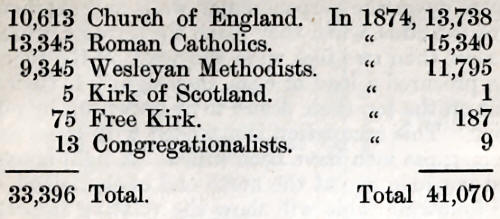
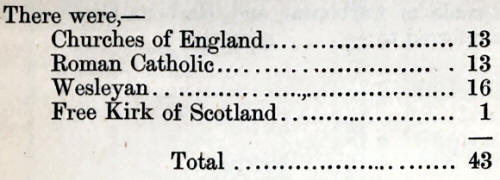
There were also 80
schools, with 4,563 scholars; and 5,493 dwelling houses. There were
12,043 acres of land under cultivation.
Ship-building has been
principally carried on at Carbonear and Harbour Grace. Within the last
few years, several large, substantial, and beautiful model vessels have
been built at Harbour Grace by the enterprising mercantile houses of the
Messrs. Ridley and Munn ; and at Carbonear by Messrs. Rorke, and others.
In the mouth of the
bay, about 50 miles from Carbonear, is the island of Baccahew (called
Baccaloas) by Cabot when he discovered Newfoundland. This was the name
Cabot gave to all the land he discovered, which signified cod-fish in
the Indian tongue. The small Island of Baccahew has long been celebrated
for it birds and eggs. This island is much frequented in the spring and
summer for the purpose of procuring the eggs of the sea birds which
breed there. Their eggs are obtained by letting persons down from the
top of the cliffs by ropes. The daring adventurers soon lose sight of
their companions, as they pass down the perpendicular walls and
overhanging parts of the cliffs, when they reach the terraces, which are
often more than two feet wide, they cast off the rope, and having
procured a load of eggs, they signify to their companions on the top
their desire to be drawn up by pulling the rope. This occupation is
attended with great danger and sometimes men have been killed. A light
house was erected not long ago at the north end of the Island.
The following table
will show the relative importance of the trade of Carbonear and Harbour
Grace at the periods referred to:—
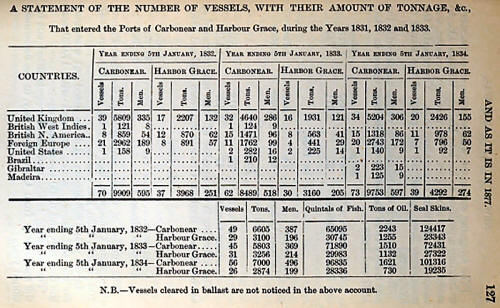
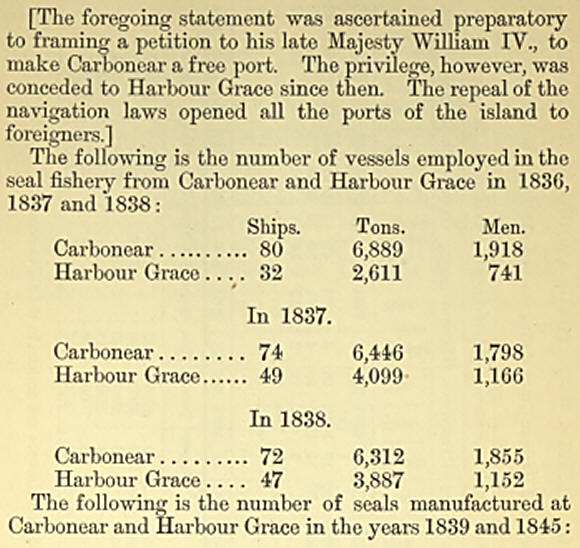
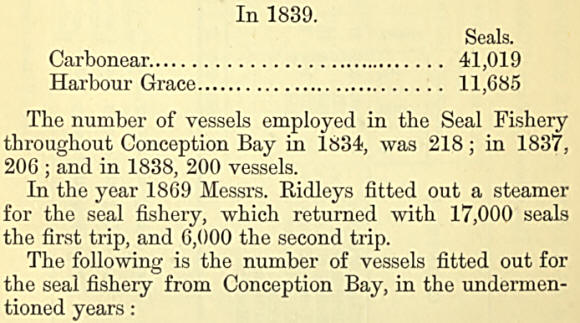
|
Vessels |
Tons. |
Men |
Quintals of
Fish. |
Tons of Oil |
Seal Skins. |
|
49 |
6605 |
387 |
65095 |
2243 |
124417 |
|
29 |
3100 |
196 |
30745 |
1255 |
23343 |
|
45 |
5803 |
369 |
71890 |
1510 |
72431 |
|
31 |
3256 |
214 |
29983 |
1132 |
27322 |
|
56 |
7000 |
496 |
96835 |
1621 |
101316 |
|
26 |
2874 |
199 |
28336 |
730 |
19235 |
N.B.—Vessels cleared in
ballast are not noticed in the above account.
The number of vessels
employed in the Seal Fishery throughout Conception Bay in 1834, was 218;
in 1837, 206 ; and in 1838, 200 vessels.
In the year 1869
Messrs. Ridleys fitted out a steamer for the seal fishery, which
returned with 17,000 seals the first trip, and 6,000 the second trip.
The following is the
number of vessels fitted out for the seal fishery from Conception Bay,
in the undermentioned years:
|
Years. |
Vessels. |
Tons. |
Men. |
Years- |
Vessels. |
Tons- |
Men. |
|
1839 |
174 |
14704 |
4818 |
1846 |
175 |
15176 |
5214 |
|
1840 |
169 |
14036 |
4674 |
1847 |
161 |
13989 |
4924 |
|
1841 |
157 |
12440 |
4431 |
1848 |
148 |
13515 |
4842 |
|
1842 |
177 |
14655 |
5040 |
1849 |
149 |
14765 |
5113 |
|
1843 |
180 |
14877 |
5098 |
1853 |
184 |
19235 |
6964 |
|
1845 |
202 |
16971 |
5628 |
|
|
|
|
In 1873, Ridley & Sons,
and John Munn & Co., of Harbour Grace, employed three steamers in the
seal fishery, besides a number of sailing vessels. The number of seals
manufactured throughout Conception Bay, in 1839, was 112,676; and in
1845 there were about 50,000 manufactured ; while at Carbonear alone, in
the year 1832, there were 124,417 seals manufactured, and at the same
place, in 1824, there were 101,316 manufactured. Nearly the whole of the
sealing vessels are employed during the summer in the Labrador cod
fishery. There is also a great number of smaller craft employed in the
fisheries, besides about 3,000 large fishing boats. The foreign trade of
Conception Bay employs about 100 vessels, from 90 to upwards of 200
tons.
At Kelly’s Island, and
Little Belle Isle, excellent, finegrained, grit-stone is abundantly
found, and from the stratification and natural cleavage is set, with
scarcely any dressing, for building. The island of Big Belle Isle is
about nine miles long and three broad. On either end of the island is a
village. Here there are some well-cultivated farms. The soil of Belle
Isle is said to be richer than any other part of Conception Bay. During
the past few years several families of natives and others belonging to
Carbonear and Harbour Grace, emigrated to various parts of the United
States, many of whom have since returned. It is not often that
Newfoundlanders leave their country. They are fond of home. The writer
cannot describe the painful emotions he felt, when, for the last time,
he saw I the dim shores of his native land die away in the distance; a
thousand fond recollections clustered around his heart, of home and
distant friends.
The number of emigrants
annually arriving at New foundland used to be between 300 and 400,
principally from Ireland. A few years ago more than double the, above
number used to arrive in a year. Now none.
“The natal soil, to all
how strangely sweet,
The place where first he breathed, who can forget;
Whate’er the cause, man still adores
The soil that gave him birth.
And tho’ awhile for distant shores
He quits his native earth,
He loves, gray-haired, to walk the shade
Where first he saw the sky,
And on the spot where first he played,
To lay him down and die.”
The following
statistics are from the Emigration Commissioners’ last Report:—
“The great impulse
given to emigration dates from the year 1847. In the forty-three years,
from 1815 to 1857 inclusive, there emigrated from the United Kingdom,
4,683,194 persons.
“Of these there went
to—
“The United
States..................2,830,687
“To British North America..........1,170,342
“To Australia and New Zealand.... 613,615
“To other places......................... 68,560
“Of the whole
emigration, more than one-half, viz., 2,441, 802, emigrated in the eight
years from 1817 to 1854 inclusive. In 1855 and 185G the emigration fell
to 176,807 and 176,554 respectively, principally in consequence of the
demand for the army and navy, and the departments connected with them,
during the Russian war. In 1857 the numbers rose again to 212, 875. The
increase was, to some extent, checked by the recruiting for the army in
India. During the first three months of 1858 the number of emigrants
amounted to only 19,146; this being the smallest emigration for the same
period in any year since 1856. The decrease was chiefly owing to the
demand for recruits ” |
